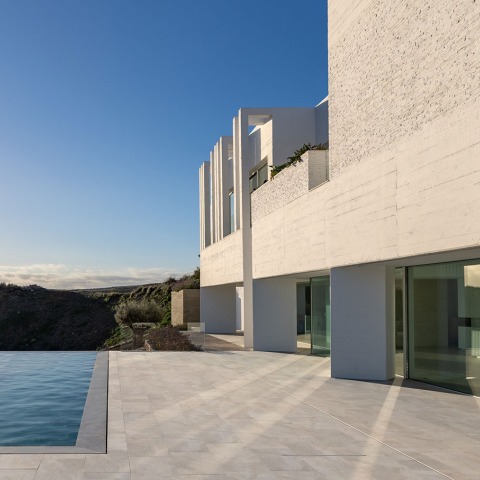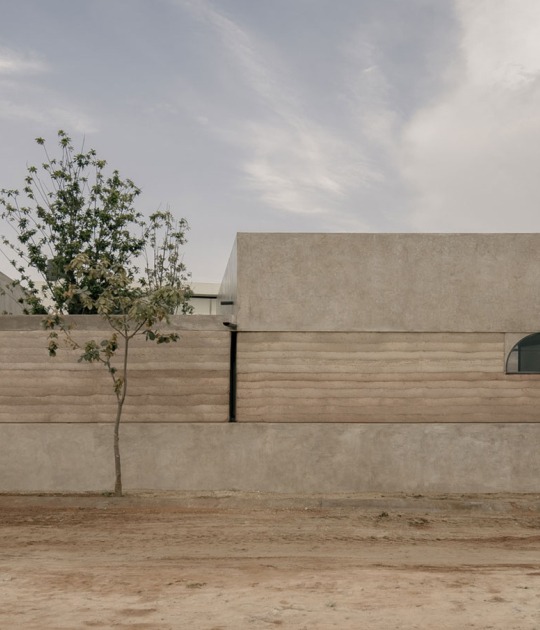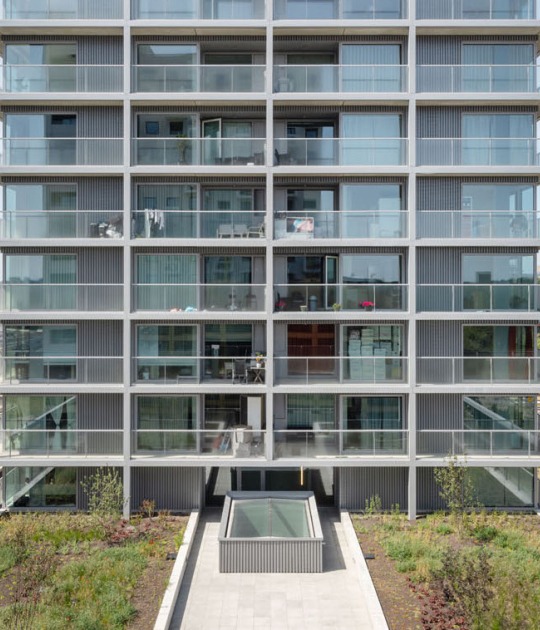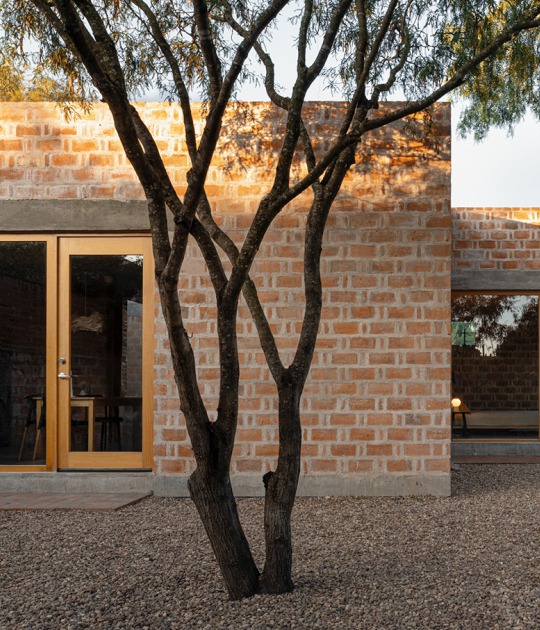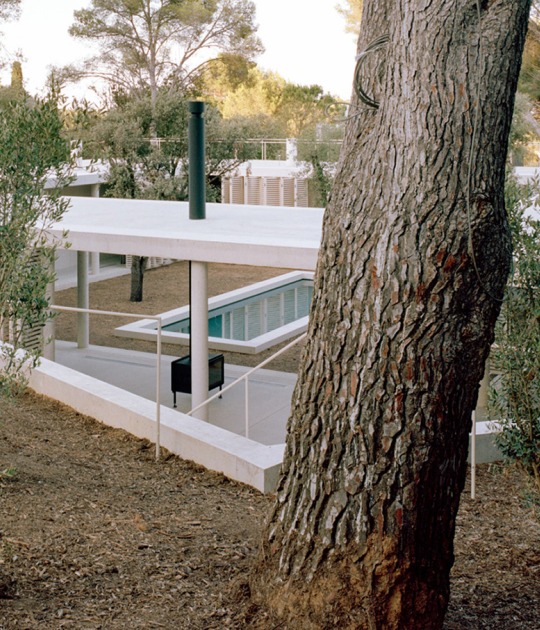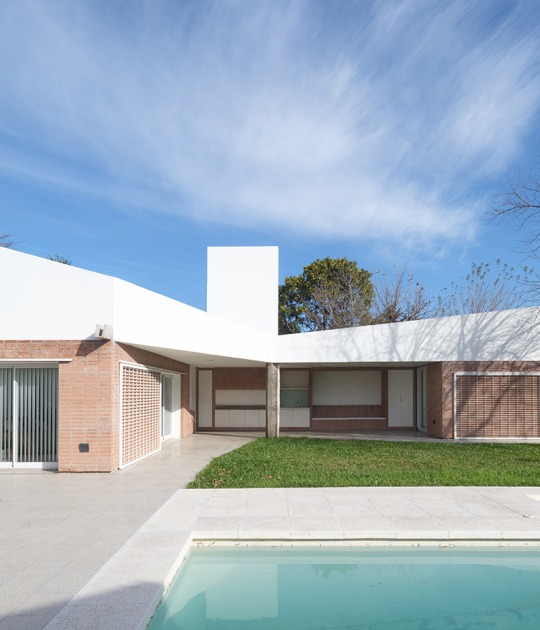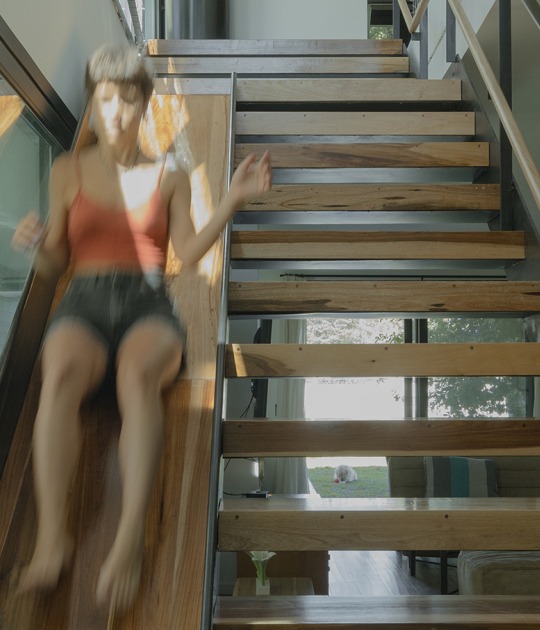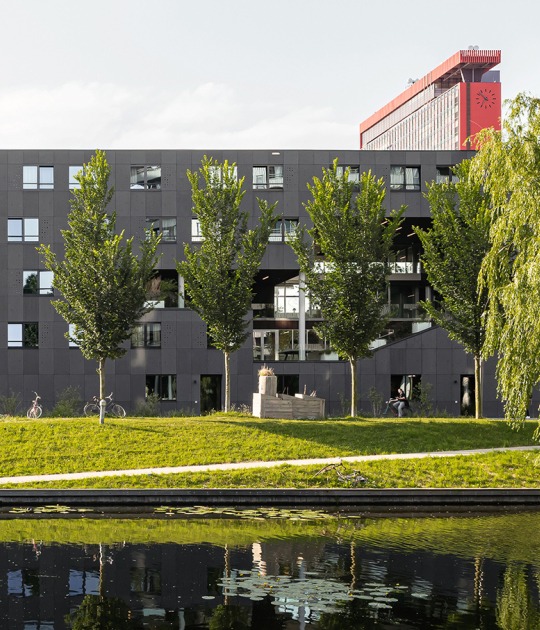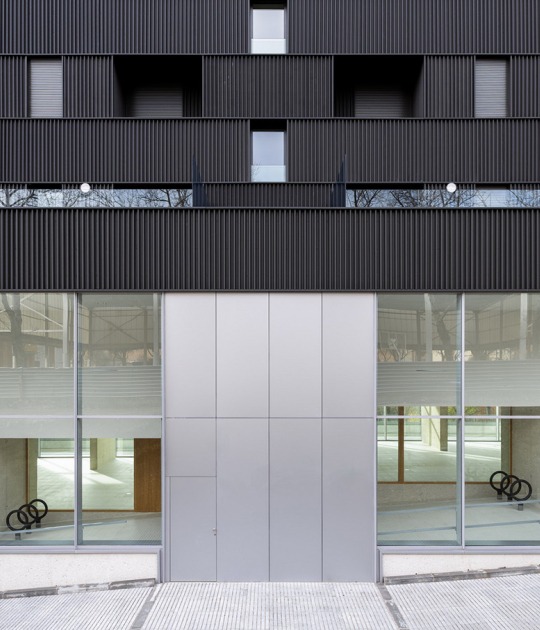The house has two main entrances, one on the upper level and the other from the pool deck, which is accessed from an exterior stone pedestrian staircase. The concrete volume on the lower level rests on five irregular triangular concrete pillars, each with different geometries that protect the glass panes from the sun and wind, while on the upper level, a lattice of concrete pillars, this time 25x25 cm squares, protects the bedrooms and staircase from direct sunlight.
The project, taking advantage of its location in the desert, makes use of passive strategies to receive the sun's energy, both in the form of lighting through the glass enclosures or the eight skylights it has, and in the form of energy conversion. In addition, the scarce rainfall is collected on the large roof and stored in cisterns for distribution to irrigate the garden.
Description of project by José Francisco García-Sánchez
Jacaranda House is radical in its materiality, it is radical in its significance, it is radical in its relationship with the landscape, it is radical in the experience that occurs when the different itineraries that are proposed are traversed, it is radical in its abstraction, it is radical in the use of natural light and it is radical in his desire to investigate new domestic landscapes.
Project
Jacaranda House is located on a sloping plot with views of the Mediterranean Sea, Cerro Negro and the fishing village of Las Negras, located in the Cabo de Gata-Níjar Natural Park, in Almería, in southern Spain. The access to the plot is made through a street located at the top of the slope.
The house presents a familiar domestic program for a four-member family with an active social life. The final proposal was shaped taking in consideration the regulatory, the budgetary limitations and some programmatic obligations after several discarded designs and some plot change.
First of all, the transformation and displacement of the land of the plot was carried out by building dry stone walls (balates) and natural terraces. This is a traditional and historical way to intervene in sloping landscapes, producing terraces where agricultural activities can be developed. Relying on one of those platforms, the Jacaranda House is built. A two-floor volume of concrete, brick and glass rests on a large horizontal platform where the pool is located. Under this platform another service space is established. Therefore, the house has three levels:
a) At the intermediate level, completely opened towards the platform where the pool is located and overlooking the sea. On this level are the living room, the kitchen, the production area and the dependent services, as well as a guest bedroom.
b) Three bedrooms are located on the upper level as well as the garage that is accessed from an outside ramp.
c) The storage and facilities area are located on the level below the pool platform.
Jacaranda House has two entrances, the first one on the upper level and the other one at the pool platform which is accessed from an exterior stone pedestrian staircase that descends from the street.
The concrete volume is placed on the lower level. It is supported by five exposed concrete pillars shaped with an irregular triangular plan. Each pillar has different geometries and they all act to protect glass panels from sun and wind. These large dimension pillars —whose sides measure more than 1 meter— are seen from the facade as flared elements that produce thickness and depth in the thresholds that are formed in the perimeter of the main floor. But some of those pillars, such as the one in the corner, when perceived from an oblique position, is presented to the viewer almost as a concrete 'paper sheet'.
On the upper level, a lattice of concrete pillars, with a 25x25 cm square section, protects the bedrooms and the staircase from direct sunlight. They are also part of the exterior image of the volume of the house.
Jacaranda House takes advantage of its location at the desert to receive energy from the sun. The lighting comes through the glass enclosures and its eight skylights. It also transforms solar power into other types of energy. The low rainfall is collected on the large deck and stored in reservoirs for distribution in the garden irrigation.
Itineraries and activities
On the platform of the ground floor —both inside and on the pool terrace— the main domestic activities of Jacaranda House are developed, allowing the exchange between the inside and the outside. Mediterranean climate allows the displacement of activities between the different areas of the house. The glazed perimeter is set back from the façade plane producing thick thresholds and intermediate places.
Jacaranda House has three interior stairs, a main one and two service stairs at the ends. Non-finite routes are proposed, allowing continuous itineraries. For example, it is possible to go up from the main floor through one of the stairs, and go down by another one. If we add the external stairs that join the three levels, the possibilities of movement are multiplied, as well as the experience of the different routes. In a similar way, all rooms and bedrooms in the house have at least two possible connections with adjacent spaces. This allows all spaces to be understood as places of stay or transit. This freedom of movement offers the inhabitant and the visitor a broader vision during the domestic experience.
Textures and influences
There is a phenomenological discourse linked to matter where texture, materiality, roughness or its behavior in the light associate it with the sensual, making the eye lose its monopoly of emotion by delegating it in to touch, hearing or smell.
Jacaranda House receives the traces and prints produced during the construction process, both on the white concrete walls and on the brick tiles, with manual and irregular invoices, of some of its walls. It is a common thing among works of architecture the coexistence of concrete built using formwork, which are made up of irregular wooden planks, and exposed brick walls.
Both materials work well together, since the formwork boards, if arranged horizontally, establish sympathetic relationships with the horizontal joints of the brickwork. In the same way, the imperfection of concrete built using this handmade system, and the arrangement of the tile bricks —which are also shaped irregularly— also help the good tuning of both systems and materials.
Jacaranda House is, somehow, heir to a tradition of architectures built of concrete and brick, especially in the 1960s and 1970s. In this sense, Jacaranda House is not away from some works by Javier Carvajal, Fernando Higueras o Miguel Fisac.
Following the Mediterranean tradition, the entire exterior façade is whitewashed, unifying materials by color, but allowing the textures and materiality of each one to emerge —except for some of the exterior walls that act as containment of the land which are left in the natural color of the cement.
Conclusions
Jacaranda House aims to present itself as a contemporary architecture that has received material and formal references of modern twentieth century architecture, but which has also investigated some issues that have been the subject of study and research throughout history, such as weight, gravity, thickness, matter or abstraction.
Jacaranda House work aims to presents itself as if it was an inhabited structure, an infrastructure arranged on the desert landscape of Cabo de Gata. The formal abstraction of this landscape coexists with the organicism with which the terracing of the plot and the garden is resolved.
